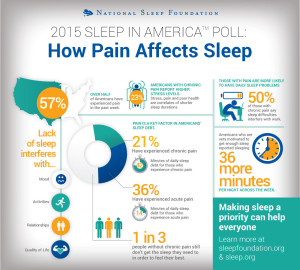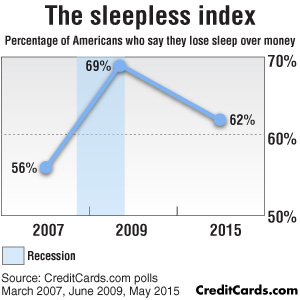 Sleeplessness and chronic pain are two epidemics that are mutually-enforcing, as the chart shows. The 2015 Sleep in America Poll found that pain is a key factor in Americans’ “sleep debt:” 21% of people have experienced chronic pain and lose 42 minutes of sleep due to it; 36% have experience acute pain, resulting in 14 minutes of lost sleep each night.
Sleeplessness and chronic pain are two epidemics that are mutually-enforcing, as the chart shows. The 2015 Sleep in America Poll found that pain is a key factor in Americans’ “sleep debt:” 21% of people have experienced chronic pain and lose 42 minutes of sleep due to it; 36% have experience acute pain, resulting in 14 minutes of lost sleep each night.
People dealing with both conditions project-manage their health in numerous ways, multitasking with over-the-counter meds, prescription drugs (from “lite” to narcotic), meditation, yoga, homeopathic remedies, aural relaxation, Mozart, and more.
There are a growing number of digital health tools now targeting these two (sadly) growing epidemics, some of which exhibited at last week’s 2016 Consumer Electronics Show.
I discussed this in The Huffington Post, in Sleep and Pain at the 2016 Consumer Electronics Show. Click on the link and you can read my take on these health issues, and some of the promising DIY digital health tools consumers can access without a prescription…
 Health Populi’s Hot Points: The second chart illustrates how financial wellness plays into sleep: when we feel financially fit, we sleep better. Note the apex of the line chart, reaching 69% of people losing sleep over money in 2009: that was the height of the Great Recession in America. By 2015, 62% of people were losing sleep due to financial stress…not a great reduction.
Health Populi’s Hot Points: The second chart illustrates how financial wellness plays into sleep: when we feel financially fit, we sleep better. Note the apex of the line chart, reaching 69% of people losing sleep over money in 2009: that was the height of the Great Recession in America. By 2015, 62% of people were losing sleep due to financial stress…not a great reduction.
Whole health is built on what we wonks call the Social Determinants of Health, money (or lack thereof) being one of them. Paying attention to financial wellness as part of overall health — and mental health — is crucially important as individuals and the national try to re-imagine a better U.S. health system.




 Interviewed live on BNN Bloomberg (Canada) on the market for GLP-1 drugs for weight loss and their impact on both the health care system and consumer goods and services -- notably, food, nutrition, retail health, gyms, and other sectors.
Interviewed live on BNN Bloomberg (Canada) on the market for GLP-1 drugs for weight loss and their impact on both the health care system and consumer goods and services -- notably, food, nutrition, retail health, gyms, and other sectors. Thank you, Feedspot, for
Thank you, Feedspot, for  As you may know, I have been splitting work- and living-time between the U.S. and the E.U., most recently living in and working from Brussels. In the month of September 2024, I'll be splitting time between London and other parts of the U.K., and Italy where I'll be working with clients on consumer health, self-care and home care focused on food-as-medicine, digital health, business and scenario planning for the future...
As you may know, I have been splitting work- and living-time between the U.S. and the E.U., most recently living in and working from Brussels. In the month of September 2024, I'll be splitting time between London and other parts of the U.K., and Italy where I'll be working with clients on consumer health, self-care and home care focused on food-as-medicine, digital health, business and scenario planning for the future...